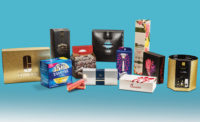Paperboard and corrugated packaging rises to the occasion
Innovations in these materials elevate the segment.








Sometimes it’s hard to get noticed when you’re a corrugated or paperboard box, especially with the rise in popularity of bags and pouches. But these sturdy and reliable containers are still necessary when talking about packaging products and ensuring product integrity. Advancements in paperboard and corrugated, and even paper packaging, not only affirm their value, they’re creating a buzz too.
These days it’s difficult to buy a case of beer without a paperboard container, and this new award-wining package mixes innovation with power. Demonstrating the unmatched strength of paperboard, the 20-can Bud Light beer carton, converted by WestRock (westrock.com), features a unique strap-style handle that is made entirely of paper. According to the company, the handle improves performance three times over similar cartons with traditional racetrack handles.
The strap distributes weight to the ends of the carton where it attaches to the minor flaps, which helps improve its strength. Additionally, the rigidity of the cans helps the carton withstand the pressure of their weight, thereby eliminating any bulging that can occur when customers pick up similar packs. The strap is also comfortable for consumers, with adequate space for the consumer’s hand, and has a reinforcement ply for a more comfortable grip. The package recently won an Innovation Award by The Paperboard Packaging Council (PPC) at its 73rd annual North American Paperboard Packaging Competition.
We’ve seen it with many brands big and small, the popularity of customization of products. As an example, Coca-Cola’s personalized bottles and cans that were an instant hit. Now, corrugated packaging can be part of the customization experience even at high volume with new capabilities at Georgia-Pacific (gpcorrugated.com).
Product packaging is what draws consumers in, keeps them engaged and tells a story. Because package design and branding is so important, Georgia-Pacific is the first corrugated packaging provider in the U.S. to purchase the new HP (hp.com) PageWide Web Press T1100S, which will uniquely give Georgia-Pacific the ability to provide customized digital pre-print for corrugated packaging at scale.
Georgia-Pacific currently has two HP digital presses, a Scitex 15500 for merchandising displays and a HP PageWide Web Press T400S in use for corrugated packaging and display pre-print applications. The newly purchased T1100S produces pre-print that matches the width of a 110-inch corrugator and produces high-quality print with four process colors (CMYK) on coated and uncoated substrates. The company states that this will give it the capability to efficiently provide volume customization from a centralized hub. In addition to faster, more efficient production and customization, digital pre-print also opens new capability for variable data printing, track and trace, and omnichannel marketing at a desired scale.
A new innovation in paper packaging is allowing consumers a dust-free and tight seal for dry foods like flour, pasta, sugar and rice. BillerudKorsnäs (billerudkorsnas.com) has collaborated with Bosch Packaging Technology (boschpackaging.com) to develop Sealed Paper Packaging made of BillerudKorsnäs Axello® ZAP – what the company says is the world’s first dust-tight, sealed all-paper packaging.
It’s a well-known problem of dusty food particles leaking out of packages, leaving a messy residue on retail shelves, pantries and countertops. Traditional glued packages do not offer tight sealing, which enables food product to migrate between air gaps during the filling process. While plastic packaging can be tightly sealed, it is a less sustainable option compared to paper. Offering retailers and consumers a sustainable alternative to plastic, BillerudKorsnäs Axello ZAP paper is FDA-certified and safe for direct food contact. The paper comes from renewable primary fibers from Nordic forests that are subject to strict environmental laws. For instance, for every tree logged, up to four new trees are planted – generating 95% more forests in Sweden now compared to the 1920s.
In addition to preventing products from leaking, Sealed Paper Packaging also safeguards contents from the external threats of mites and other insects. The material has been engineered to provide an optimal balance of breathability yet strength to protect food contents while ensuring a seal-tight adhesion between the fiber and sealing agent.
Corrugated versus plastic: The proof is in the bacteria count
New scientific work explains why corrugated packaging outperforms returnable plastic containers (RPCs) when it comes to micro-biological contamination. The work, conducted by Professor Rosalba Lanciotti and her research team at the University of Bologna’s Department of Agricultural and Food Sciences and published in Frontiers in Microbiology, follows a research study published last year that showed corrugated containers keep fruit and vegetables fresh up to three days longer than RPCs.
Lanciotti’s recent work reveals that microorganisms die much quicker when placed on corrugated surfaces where they get trapped in the paper fibers and die due to a lack of water and nutrients. Conversely, the research showed that microorganisms survive longer on plastic surfaces.
“The ability of corrugated packaging to trap microorganisms and pull them away from fruits and vegetables is a clear sign that produce will arrive fresher and last longer packed in corrugated boxes,” says Dennis Colley, president and CEO of the U.S.-based Fibre Box Association (FBA).
Looking for a reprint of this article?
From high-res PDFs to custom plaques, order your copy today!











